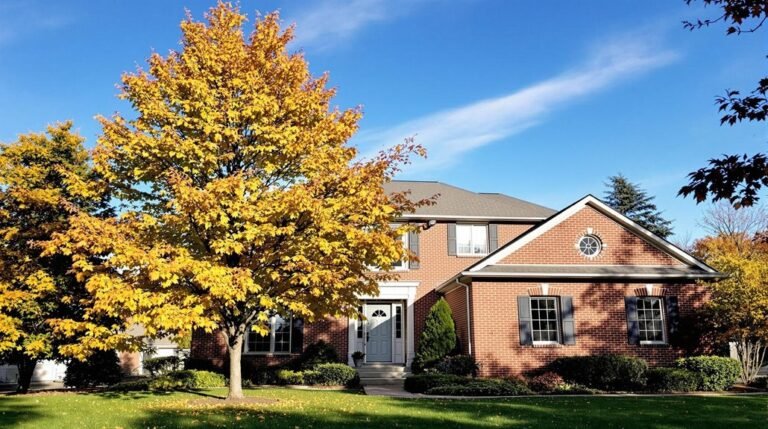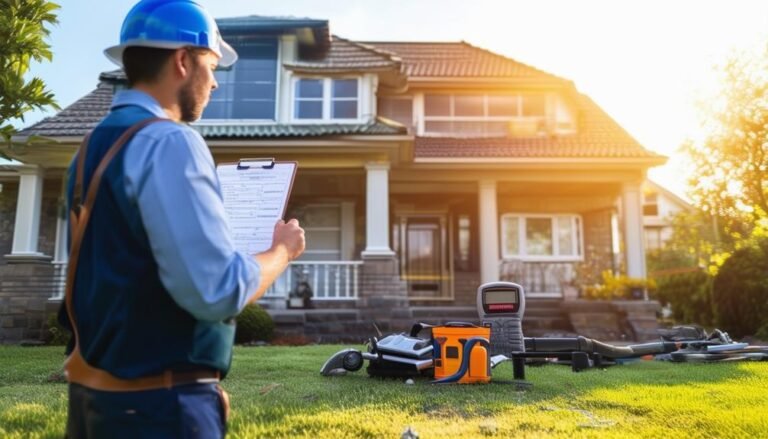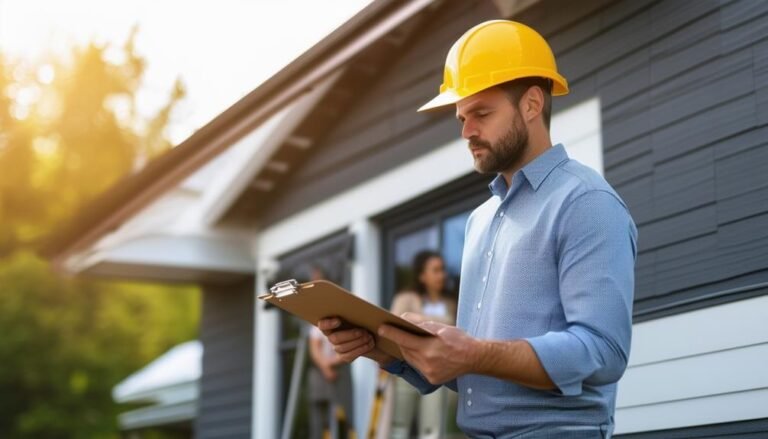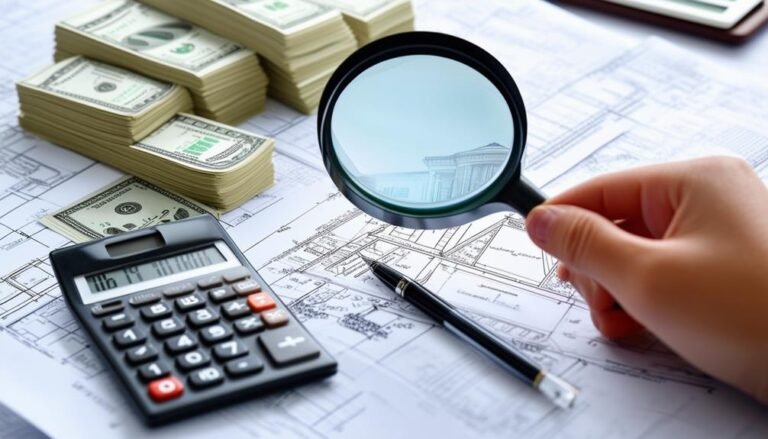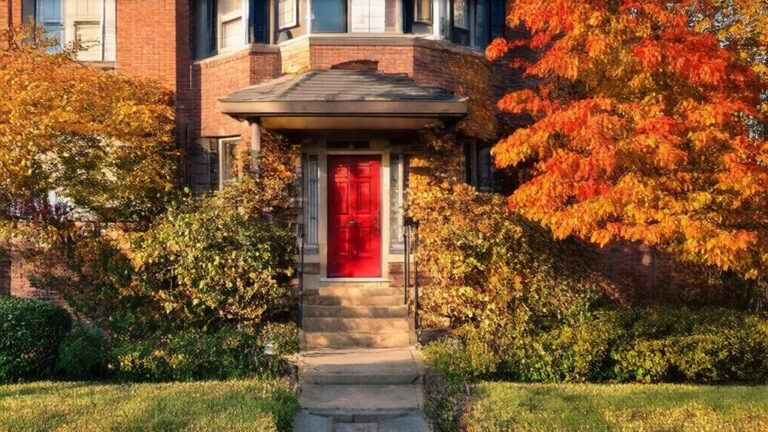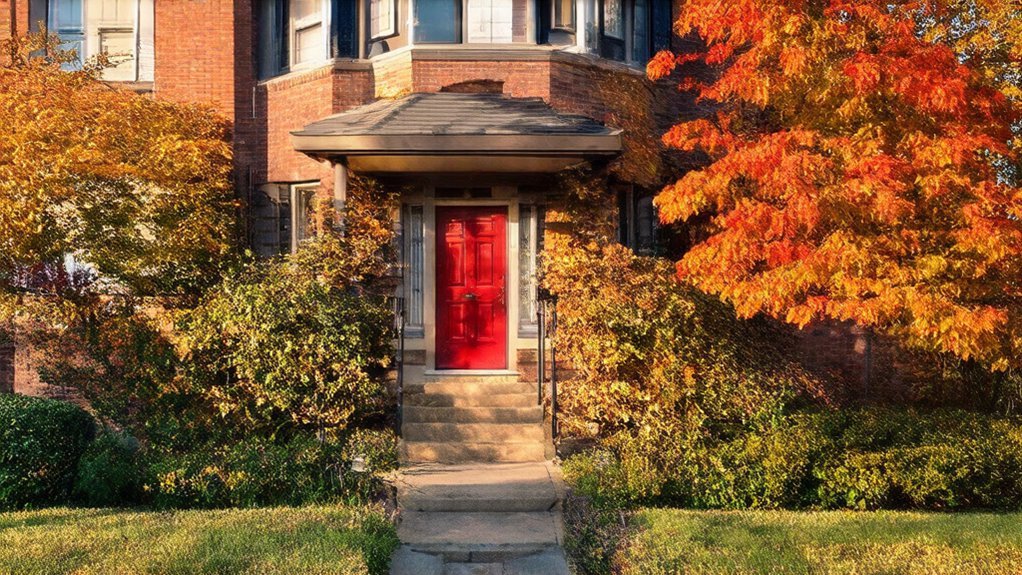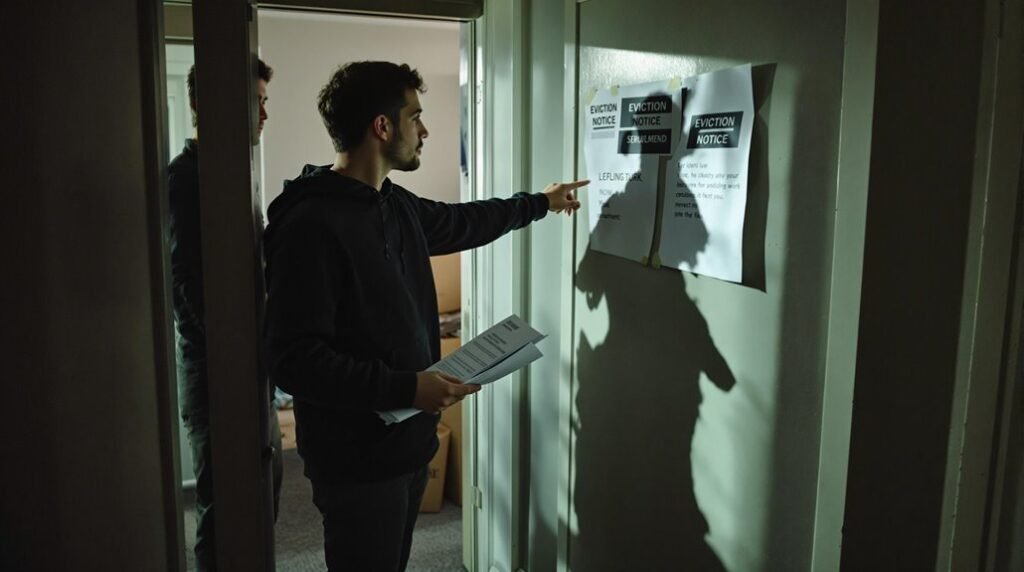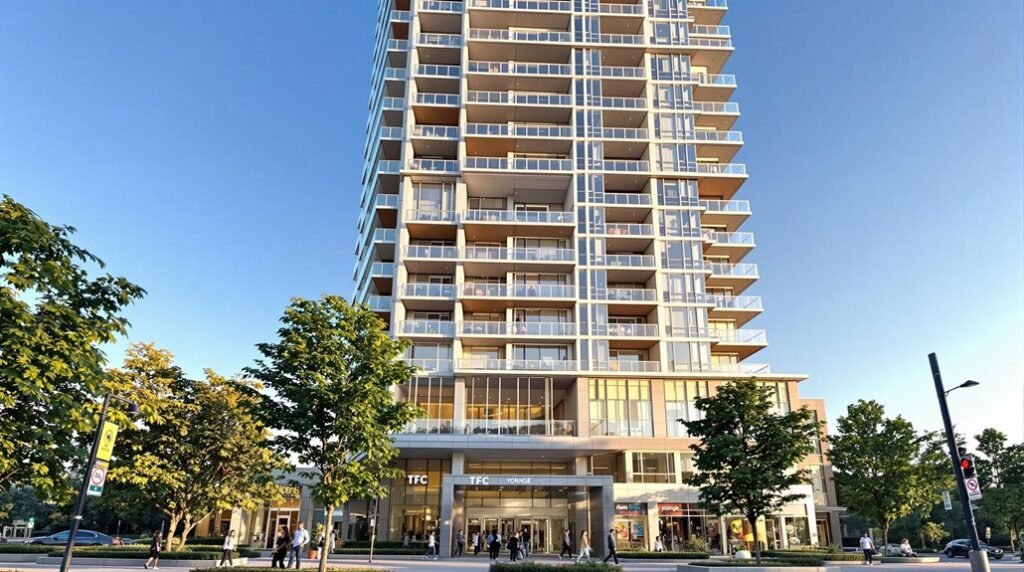Home inspections frequently uncover structural issues like foundation settlement and cracks, electrical deficiencies including outdated wiring and panels, and roofing concerns such as loose shingles and improper installation. You'll often find plumbing problems like leaky pipes and outdated materials, as well as HVAC system inefficiencies. Safety hazards and code violations are common, ranging from faulty wiring to missing smoke detectors. Pest infestations and wood decay can compromise a home's integrity, while drainage and moisture issues may lead to water damage. Regular maintenance and prompt repairs are essential for preserving your home's value and safety. Further exploration of these issues can help you better understand their implications and potential solutions.
Structural and Foundation Problems
A home's foundation is its backbone, and structural issues can be telltale signs of trouble brewing beneath the surface. When inspecting a property, you'll want to pay close attention to indicators of foundation settlement or movement. Misaligned doors and windows, for instance, can point to underlying structural problems that require immediate attention.
Foundation cracks, while common in many homes, shouldn't be overlooked. Minor cracks can often be repaired to maintain the structural integrity of your home. However, more significant fissures may indicate severe foundation issues that necessitate professional assessment. Addressing these problems proactively can prevent costly repairs down the line.
Structural repairs vary in complexity and cost. The national average for foundation repair ranges from $4,500 to $12,000, depending on the extent of the damage. This investment, while substantial, is essential for ensuring the long-term stability and safety of your home.
Prevention is key when it comes to foundation issues. Regular inspections and maintenance can help identify potential problems before they escalate. If you notice signs of settling or movement, such as uneven floors or sticking doors, it's essential to consult with a structural engineer or foundation specialist.
Electrical System Deficiencies
Your home's electrical system is an essential component that requires thorough examination during inspections, with issues arising in 85% of cases. This high occurrence highlights the significance of addressing electrical problems promptly to guarantee both safety and functionality.
When assessing your home's electrical system, inspectors often highlight several key considerations. Aluminum wiring, commonly utilized in homes constructed between 1965 and 1973, presents a notable fire hazard due to its tendency to overheat and loosen at connections. Outmoded panels, especially Zinsco and Federal Pacific models, are another warning sign. These panels may not trip when overloaded, heightening the risk of electrical fires.
Circuit hazards are another prevalent problem. Having two branch circuit wires on one breaker, referred to as double tapping, can result in overheating and potential fire risks. This issue, alongside other wiring concerns, frequently requires professional assistance to ensure your home's electrical system complies with current safety standards.
If your inspection uncovers significant electrical deficiencies, you may need to contemplate a panel replacement. The expenses for this upgrade can vary widely, with the national average ranging from $1,000 to $3,000. While this represents a significant investment, it is essential for upholding your home's safety and averting potential disasters.
Roofing and Exterior Issues

While electrical problems are common, shifting focus to the home's exterior reveals another vital area of concern: roofing and exterior issues, which can greatly impact a property's structural integrity and value. Home inspections frequently uncover roofing deficiencies, such as loose or missing shingles, that can lead to water damage if left unaddressed. Improper roof installation is another significant problem, potentially resulting in structural issues and leaks that compromise the home's overall integrity.
It's important to address roofing issues promptly to prevent costly repairs and potential interior damage. During inspections, exterior problems like damaged flashing or deteriorating siding are also identified. These issues, if neglected, can result in water penetration, mold growth, and decreased property value. Additionally, gutter maintenance is essential for proper water drainage, while landscaping concerns may affect the foundation's stability.
Inspectors also pay close attention to chimney damage and window maintenance. Cracked or deteriorating chimneys can pose safety hazards and lead to water intrusion, while poorly maintained windows may cause energy inefficiency and allow moisture to enter the home. By identifying these issues early, homeowners can take proactive measures to protect their investment and guarantee the longevity of their property.
Plumbing and Water Damage
From leaky faucets to burst pipes, plumbing issues rank among the most common and potentially damaging problems uncovered during home inspections. In fact, 75% of inspections reveal plumbing-related concerns, ranging from minor leaks to outdated systems that require immediate attention. These issues, if left unaddressed, can lead to significant water damage, weakening the structure of your home and resulting in costly repairs.
One of the most critical aspects of plumbing maintenance is leak detection and prevention tactics. Regular inspections of visible pipes, fixtures, and water-using appliances can help identify potential problems before they escalate. Pay close attention to signs of pipe corrosion, such as discoloration, flaking, or small bubbles forming on the surface. These indicators suggest that your pipes may be deteriorating and at risk of failure.
If your home has older plumbing materials like Polybutylene Plastic (PB) supply pipes, you should consider replacement. PB pipes are notorious for their tendency to break down and cause extensive water damage. The national average cost for replacing supply pipes ranges from $1,500 to $2,500, but this investment can save you from more expensive repairs down the line. Copper piping is a preferred alternative due to its durability and reliability compared to older materials like PB, cast iron, or galvanized pipes.
HVAC and Ventilation Concerns

Just as plumbing issues can wreak havoc on a home, HVAC and ventilation problems often surface during inspections, potentially impacting both comfort and safety. Home inspectors meticulously evaluate these systems to make sure they're functioning properly and don't pose any risks to occupants.
One key aspect of HVAC evaluation is the inspection of gas furnaces. If you notice a non-blue flame color, it could indicate incomplete combustion or other issues that require immediate attention. This problem might stem from various factors, including improper gas-to-air ratio or a dirty burner.
Regular maintenance is essential for HVAC systems, and filter replacement is a simple yet necessary task. Neglecting this can lead to reduced efficiency, poor air quality, and increased energy costs. During inspections, you'll often find that homeowners have overlooked this basic maintenance step.
Ductwork inspection is another vital component of HVAC evaluation. Inspectors check for leaks, damage, or improper installation that could compromise the system's efficiency. They may also assess insulation quality and look for signs of mold or pest infestations within the ducts.
A particularly serious issue that may arise during inspections is a cracked heat exchanger. This problem can allow carbon monoxide to leak into your living space, posing a severe health risk. If discovered, it often requires immediate repair or replacement of the furnace.
Insulation and Energy Efficiency
Proper insulation and energy efficiency are pivotal factors that home inspectors scrutinize, as they directly impact a home's comfort, utility costs, and environmental footprint. During an inspection, professionals assess the quality and quantity of insulation in key areas such as attics, walls, and crawl spaces. They'll evaluate various insulation types, including fiberglass, cellulose, and foam, to determine their effectiveness in maintaining thermal barriers.
Inadequate attic insulation is a common issue uncovered during inspections. You may be losing significant heat through your roof if your attic isn't adequately insulated. This can lead to higher energy bills and reduced comfort in your living spaces. Home inspectors will measure insulation depth and R-value to confirm it meets current standards for your climate zone.
Energy saving strategies are another essential aspect of the inspection process. Professionals will look for gaps in weatherstripping around doors and windows, which can cause drafts and energy loss. They'll also check for proper sealing of ductwork and assess the overall air tightness of your home.
The benefits of addressing insulation and energy efficiency issues are substantial. You can reduce your energy costs by up to 30% with proper insulation, leading to significant long-term savings. Additionally, energy-efficient homes often have higher resale values due to their lower utility bills. You may also qualify for energy efficiency rebates by upgrading your insulation, further offsetting improvement costs.
Safety Hazards and Code Violations

Safety hazards and code violations are red-flag issues that home inspectors vigilantly seek out during their thorough examinations of properties. These concerns can range from exposed wiring to missing smoke detectors, and they're often the result of maintenance neglect or outdated building materials and fixtures. Identifying these issues is essential for ensuring the safety of occupants and compliance with local building codes.
When inspecting a home, professionals are trained to spot potential dangers and regulatory non-compliance. Here are some common safety hazards and code violations you should be aware of:
- Electrical issues: Faulty wiring, overloaded circuits, and improper grounding can pose serious fire hazards.
- Structural problems: Inadequate support beams, improperly installed handrails, or non-compliant stairways can lead to accidents.
- Fire safety violations: Missing or non-functional smoke detectors, lack of fire barriers, or blocked escape routes can compromise occupant safety.
Addressing these issues promptly is necessary for maintaining a safe living environment. Outdated fixtures, such as old electrical panels or plumbing components, may not meet current safety standards and could require immediate attention. Additionally, the use of certain building materials that are now known to be hazardous, like asbestos or lead-based paint, may be uncovered during inspections.
It's important to note that while some safety hazards are obvious, others may be less apparent to the untrained eye. This is why professional home inspections are crucial in identifying potential risks and ensuring that a property meets all regulatory standards. By addressing these issues, you're not only protecting the occupants but also potentially avoiding costly fines and legal complications down the line.
Pest Infestations and Wood Decay
When it comes to structural threats, pest infestations and wood decay rank among the most sneaky problems a home inspector can uncover. These issues can compromise the integrity of your home, leading to extensive damage and costly repairs if left unaddressed.
Termites and carpenter ants are notorious for their ability to silently destroy wood structures. These pests can wreak havoc on your home's framework, causing notable damage before you even realize there's an issue. Similarly, wood decay, often caused by fungi and excess moisture, can weaken support beams, floor joists, and other vital components of your home's structure.
Prevention methods are essential in protecting your home from these threats. Regular inspections, proper ventilation, and moisture control are crucial steps in maintaining a healthy home environment. Additionally, treating exposed wood with protective sealants and using pest-resistant materials can significantly lessen the risk of infestations and decay.
The environmental impact of pest infestations and wood decay extends beyond your home. Untreated issues can lead to increased energy consumption due to compromised insulation and air leaks. Furthermore, the chemicals used in some pest control treatments may have adverse effects on surrounding ecosystems if not applied responsibly.
Home inspectors are trained to identify early signs of pest activity and wood decay. They look for evidence such as mud tubes, wood shavings, or discolored, soft wood. By catching these problems early, you can implement targeted treatments and repairs, potentially saving thousands of dollars in extensive renovations and ensuring the long-term safety and stability of your home.
What Common Issues Can Home Inspections Uncover That Appraisals Cannot?
During a home inspection, inspectors can uncover issues such as structural damages, water leaks, and safety hazards that may not be visible during appraisals. The appraisals vs inspections difference lies in the fact that appraisals focus on determining the value of the property, while inspections focus on identifying potential problems.
Drainage and Moisture Issues

In light of potential water damage, you’ll want to pay close attention to your home’s drainage and moisture issues during an inspection. Home inspectors are trained to identify problems that can lead to basement moisture, mold growth, and even structural damage. Proper yard grading is essential for guaranteeing water flows away from your home’s foundation, preventing these costly issues.
When addressing drainage concerns, consider these necessary steps:
- Assess your current landscaping and grading
- Implement effective waterproofing techniques
- Monitor and maintain drainage systems regularly
Landscaping solutions play a crucial role in managing water flow around your property. Guarantee your yard slopes away from the foundation, with a grade of at least six inches over a distance of ten feet. This helps direct water away from your home’s perimeter. Additionally, consider installing French drains or dry wells to collect and redirect excess water.
Waterproofing techniques are another vital aspect of protecting your home from moisture intrusion. Apply waterproof sealants to your foundation walls, both inside and out, to create a barrier against water penetration. Install a sump pump in your basement or crawl space to remove any water that may accumulate.
Conclusion
As you navigate the maze of home inspections, you’ll encounter a spectrum of potential issues. From structural flaws to electrical hazards, roofing defects to plumbing problems, these inspections uncover the hidden challenges within a property. By understanding common concerns like HVAC inefficiencies, insulation inadequacies, safety violations, pest infestations, and drainage issues, you’re better equipped to make informed decisions. Armed with this knowledge, you can confidently assess a home’s condition and negotiate repairs or adjustments accordingly.
Ready to navigate the twists and turns of home inspections with confidence? Realtor North York – The Fan Team is here to guide you every step of the way. Whether you’re buying or selling, our expert North York real estate agents will help you understand the ins and outs of your property’s condition. Contact us today to ensure you make the best-informed decisions and negotiate the right repairs or adjustments. With The Fan Team, your dream home in North York is just a call away!



